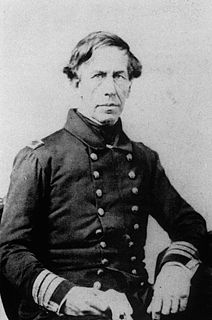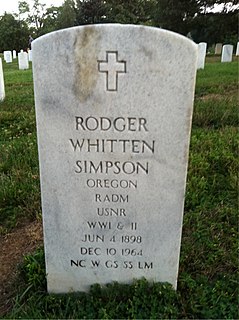See also
| This article includes a list of ships with the same or similar names. If an internal link for a specific ship led you here, you may wish to change the link to point directly to the intended ship article, if one exists. |
USS Wilkes may refer to:
| This article includes a list of ships with the same or similar names. If an internal link for a specific ship led you here, you may wish to change the link to point directly to the intended ship article, if one exists. |

Bath Iron Works (BIW) is a major United States shipyard located on the Kennebec River in Bath, Maine, founded in 1884 as Bath Iron Works, Limited. BIW has built private, commercial, and military vessels, most of which have been ordered by the United States Navy. The shipyard has built and sometimes designed battleships, frigates, cruisers, and destroyers, including the Arleigh Burke class which are currently among the world's most advanced surface warships.

Charles Wilkes was an American naval officer, ship's captain, and explorer. He led the United States Exploring Expedition, 1838-1842. His behavior led to two convictions by court-martial, one stemming from the massacre of almost 80 Fijians on Malolo in 1840. During the American Civil War (1861–1865) he commanded USS San Jacinto during the Trent Affair, where he stopped a Royal Mail Ship and removed two Confederate diplomats, which almost led to war between the US and the UK.

The Fletcher class was a class of destroyers built by the United States during World War II. The class was designed in 1939, as a result of dissatisfaction with the earlier destroyer leader types of the Porter and Somers classes. Some went on to serve during the Korean War and into the Vietnam War.
Three ships of the United States Navy have been named USS Chauncey to honor Commodore Isaac Chauncey.

The Clemson class was a series of 156 destroyers which served with the United States Navy from after World War I through World War II.
A destroyer squadron is a naval squadron or flotilla usually consisting of destroyers rather than other types of vessel. In some navies other vessels, such as frigates, may be included. In English the word "squadron" tends to be used for larger and "flotilla" for smaller vessels; both may be used for destroyer units. Similar formations are used in non-English-speaking countries, e.g., the "escadrille"—which would translate directly as "squadron"—in France.
USS Porter may refer to one of several ships in the United States Navy named in honor of Commodore David Porter, and his son, Admiral David Dixon Porter.

USS Wilkes (DD-67) was a Sampson-class destroyer in the United States Navy during World War I. She was the second Navy ship named for Commodore Charles Wilkes (1798–1877). She served with the United States Coast Guard as (CG-25).
USS O'Brien has been the name of five ships of the United States Navy, in honor of Jeremiah O'Brien (1744–1818):

The Benson class was a class of destroyers of the U.S. Navy built 1939–1943. The thirty 1,620-ton Benson-class destroyers were built in two groups. The first six were authorized in fiscal year 1938 (FY38) and laid down at Bethlehem Steel, Quincy, Massachusetts, and three naval shipyards. The remaining 24 “repeat Bensons” were authorized in 1940–42 and built at four Bethlehem Steel yards. They were laid down after the first group was commissioned. These plus the “repeat Livermores” were also known at the time as the Bristol class. During World War II the Bensons were usually combined with the Livermores as the Benson-Livermore class; this persisted in references until at least the 1960s. In some references both classes are combined and called the Benson class. The Benson- and Gleaves-class destroyers were the backbone of the pre-war Neutrality Patrols and brought the action to the enemy by participating in every major campaign of the war.

Charles Turner Joy was an admiral of the United States Navy during World War II and the Korean War. During the last years of his career, he served as Superintendent of the Naval Academy. The destroyer USS Turner Joy (DD-951) was named for him.

The Gleaves-class destroyers were a class of 66 destroyers of the United States Navy built 1938–42, designed by Gibbs & Cox. The first ship of the class was USS Gleaves. They were the production destroyer of the US Navy when it entered World War II.

USS Corry (DD-334) was a United States Navy Clemson-class destroyer launched and commissioned in 1921.

The Gridley-class destroyers were a class of four 1500-ton destroyers in the United States Navy. They were part of a series of USN destroyers limited to 1,500 tons standard displacement by the London Naval Treaty and built in the 1930s. The first two ships were laid down on 3 June 1935 and commissioned in 1937. The second two were laid down in March 1936 and commissioned in 1938. Based on the preceding Mahan-class destroyers with somewhat different machinery, they had the same hull but had only a single stack and mounted sixteen 21 inch (533 mm) torpedo tubes, an increase of four. To compensate for the increased torpedo armament weight, the gun armament was slightly reduced from five 5"/38 caliber guns (127 mm) to four. USS Maury (DD-401) made the highest trial speed ever recorded for a United States Navy destroyer, 42.8 knots. All four ships served extensively in World War II, notably in the Solomon Islands and the Battle of the Philippine Sea, with Maury receiving a Presidential Unit Citation.

USS Richard P. Leary (DD-664) was a Fletcher-class destroyer of the United States Navy, named for Rear Admiral Richard P. Leary (1842–1901). In 1959, the ship was transferred to the Japanese Maritime Self-Defense Force and renamed Yūgure. The destroyer remained in service with the Japanese until 1974, when she was returned to the US, who then sold the ship for scrap in 1976.

The Federal Shipbuilding and Drydock Company was a United States shipyard, active from 1917 to 1948. It was founded during World War I to build ships for the United States Shipping Board. During World War II, it built ships as part of the U.S. Government's Emergency Shipbuilding program. Operated by a subsidiary of the United States Steel Corporation, the shipyard was located at Kearny Point where the mouth of the Hackensack River meets Newark Bay in the Port of New York and New Jersey. The shipyard site is now part of River Terminal, a massive distribution facility that is partially a foreign trade zone.
"Destroyer minesweeper" was a designation given by the United States Navy to a series of destroyers that were converted into high-speed ocean-going minesweepers for service during World War II. The hull classification symbol for this type of ship was "DMS." Forty-two ships were so converted, beginning with USS Dorsey (DD-117), converted to DMS-1 in late 1940, and ending with USS Earle (DD-635), converted to DMS-42 in mid 1945. The type is now obsolete, its function having been taken over by purpose-built ships, designated as "minesweeper (high-speed)" with the hull classification symbol MMD.

Rodger Whitten Simpson was a rear admiral of the United States Navy, who distinguished himself during World War II. The frigate USS Simpson (FFG-56) was named in his honor.

Admiral James Fife Jr. was a United States Navy admiral who was promoted to four star rank after retirement as a "tombstone admiral".

USS Abner Read (DD-769) was a planned United States Navy Gearing-class destroyer laid down during World War II but never completed. The ship was to be the second ship named for Abner Read (1821–1863), a United States Navy officer killed during the American Civil War. She was assigned the name during construction when the first Abner Read (DD-526), a Fletcher-class destroyer, was sunk by a kamikaze during the Battle of Leyte, 1 November 1944.